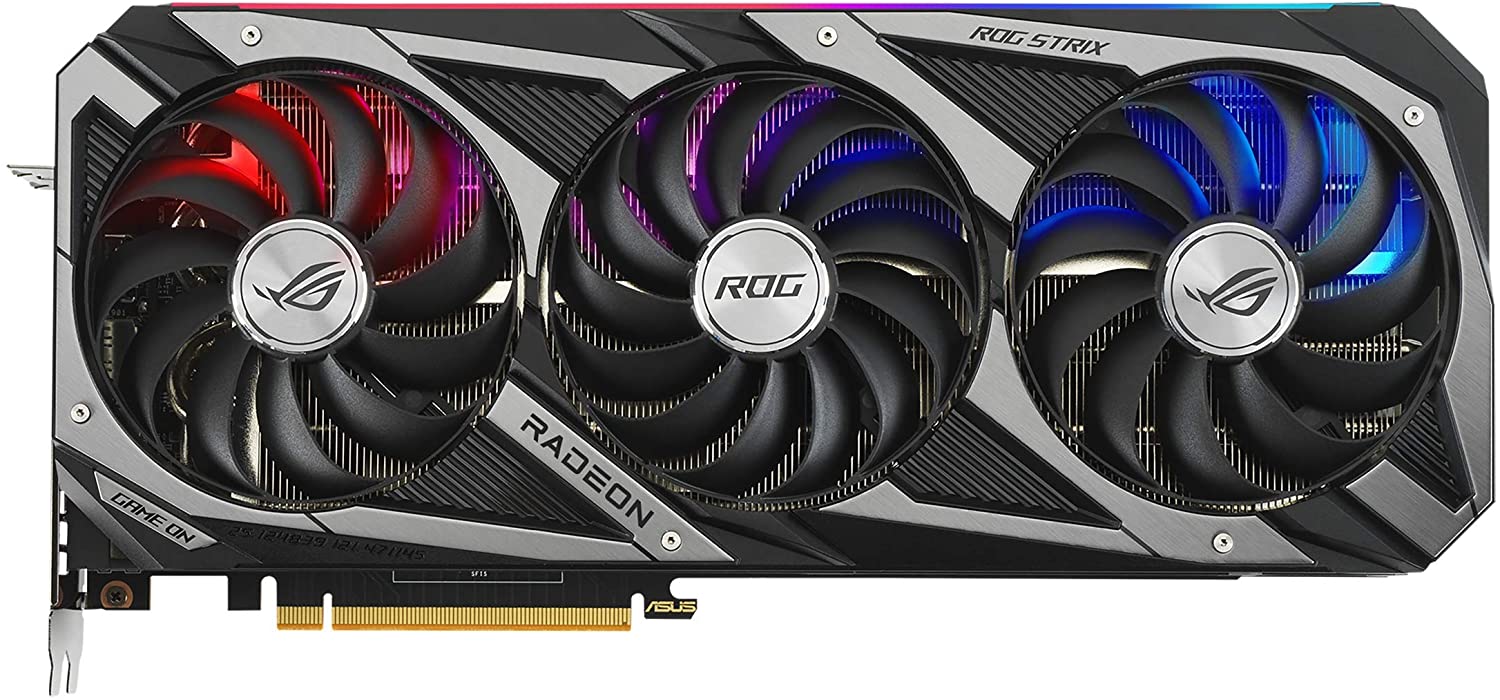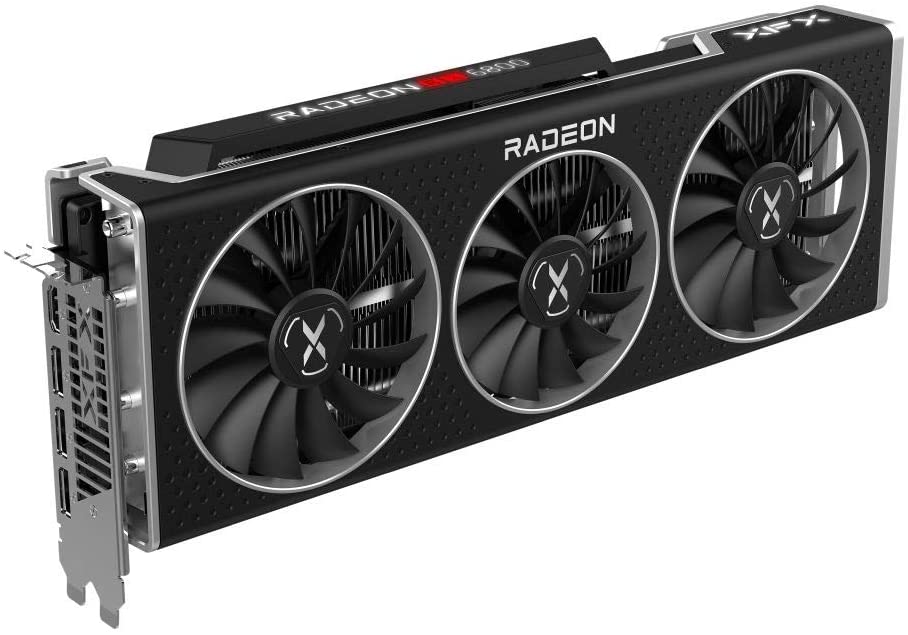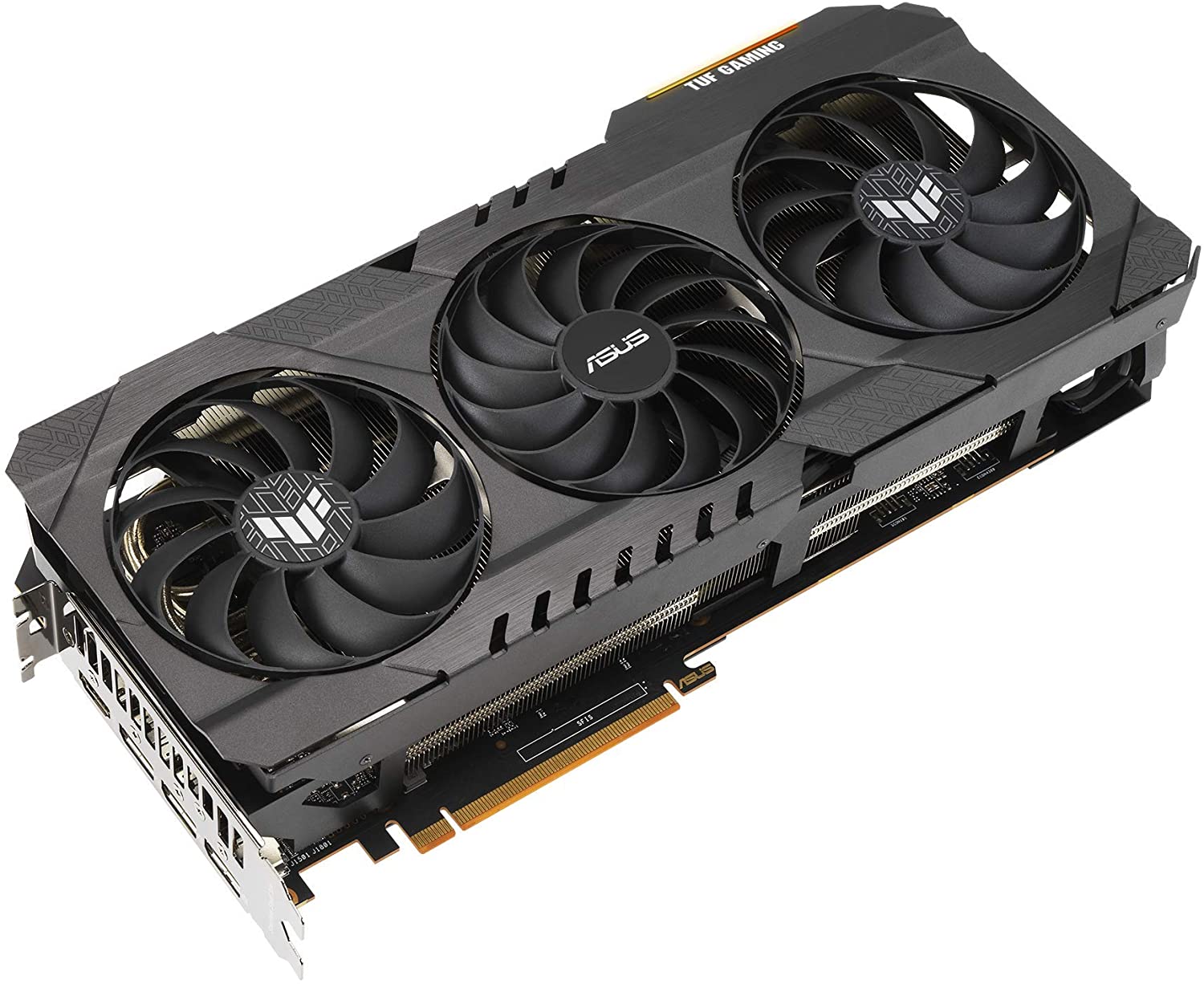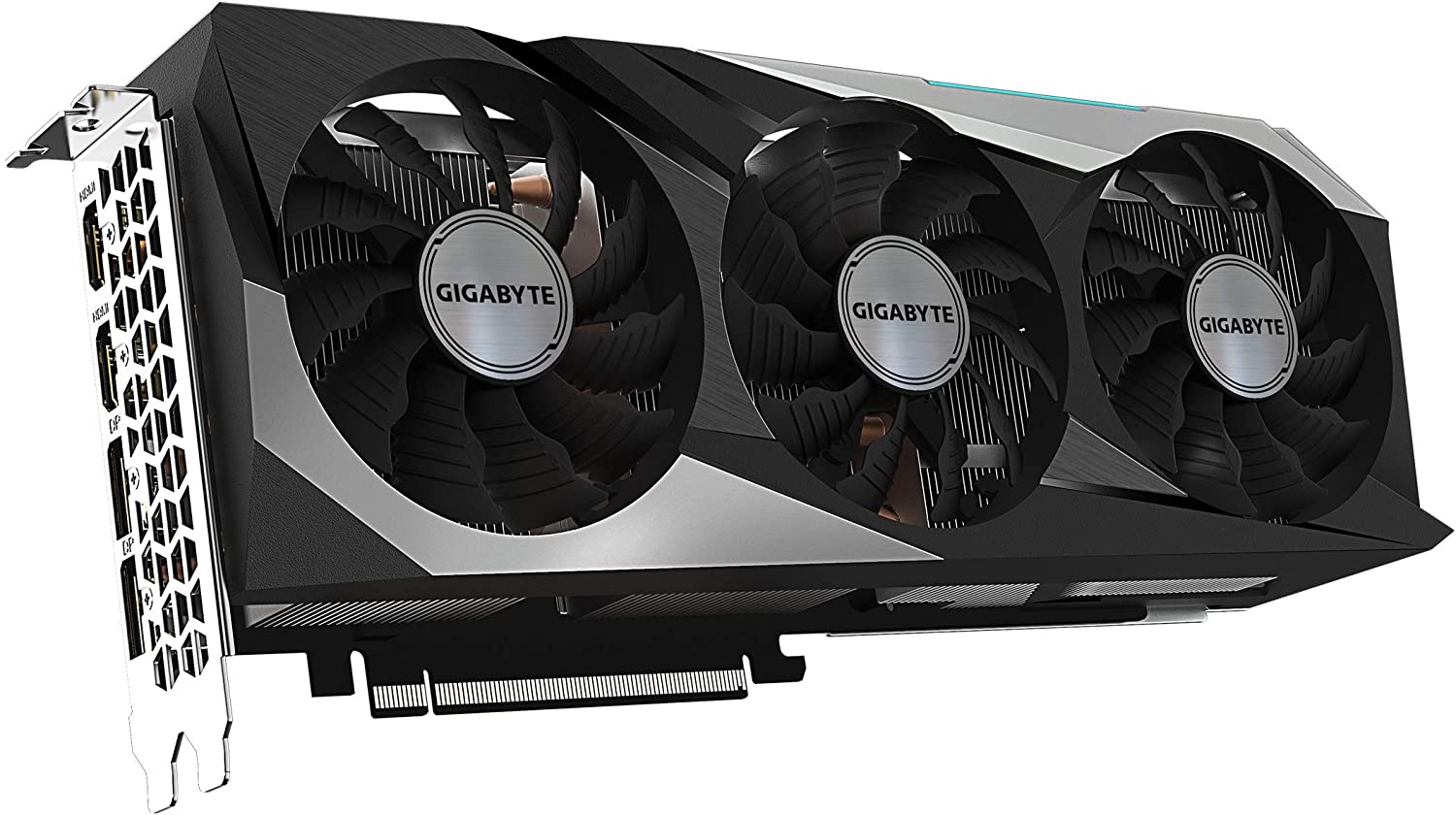The Radeon RX 6800 is currently the least powerful and the most affordable RX 6000 series graphics card out there. That does not mean, however, that the RX 6800 is slow by any stretch of the word. In pure gaming benchmarks in rasterized rendering, the RX 6800 is often about 8-12% faster than the GeForce RTX 3070. This impressive graphics card from AMD has an expected MSRP of $579, however, due to current stock problems and low availability issues the prices have been inflated. This guide is supposed to be a reference for future buyers when the stock and pricing situation finally normalizes.
Best RX 6800: Our Top 5 Recommendations
The RX 6800 is a higher-end graphics card for those who want to get extraordinary performance at an ordinary cost. With an MSRP of $579, it’s not exactly cheap but a good runner-up option when stacked against the likes of RX 6800 XT and RX 6900 XT. At a shiny price point and amazing performance, it goes head to head with the RTX 3070 Ti and even the RTX 3080. The Nitro+ from Sapphire has always been one of the top partner models for any AMD card and this one is no exception. The Sapphire Nitro+ RX 6800 features a big bulky heatsink for exceptional cooling performance while being one of the best-looking RX 6800 cards on the market. The card also features a really high boost clock of 2,190 MHz out of the box which is the highest of any RX 6800 model.
For the cooling system, Sapphire has gone with a really big GPU cooler with several copper pipes and a unique design to keep the temperatures down. The card actually features multiple heatsinks for the different heat-generating components like the GPU die, memory modules, and VRM components. The heatsink features a unique wave-shaped fin design with V-shaped cutouts to improve heat dissipation. Acoustic performance has always been one of the strongest points of Sapphire’s Nitro+ series and the trend carries on with the RX 6800. Sapphire has gone with 3 fans on the fan shroud that feature an interesting design. The fan design is actually a hybrid of an axial fan and a blower fan which gives you the quietness of an axial fan combined with the higher airflow of the blower fan. This keeps the noise levels low while also increasing the heat dissipation ability of the card even under load. You can read more about downdraft, vapor chamber, and blower-style coolers in our opinion piece as well. Sapphire has also included a triple BIOS with the Nitro+ RX 6800 which is great news for overclockers. The TDP of the GPU is also fairly high which will help achieve more stable overclocks as well. The additional cooling on the memory and the VRMs via the extra heatsink and heat pipes is also a great step in this process. The power delivery system of the Nitro+ is fairly robust, so overclocking on this card should be really fun. Helpful Roundup: 5 Best Airflow Case Options to Buy in 2021 Aesthetically, Sapphire has gone with a sleek industrial design that looks fairly modern and minimalistic at the same time. The main fan shroud is metallic silver while the backplate features a somewhat aggressive design. RGB is also plentiful while also being tasteful, and any lighting on the card can be controlled fairly easily via the TriXX software from Sapphire. Overall the Nitro+ is a really fantastic aftermarket variant and the best overall RX 6800. It does come at a price premium, but the robust cooling and great performance make it a worthy investment. One of the most premium variants of any graphics card on the market has always been the ASUS ROG Strix. Not only does the Strix have exceptional performance in terms of cooling and noise, but it is also one of the best-looking graphics cards out there. It often does come at a hefty premium, but buyers are willing to pay for the quality that the Strix brings to the table. A similar Strix model was also included in our roundup of the best RTX 3060 graphics cards.
The cooling system implemented in the ROG Strix RX 6800 is a really premium one that combines a large finned heatsink with some powerful and quiet fans. ASUS has installed a 2.9 slot thick heatsink in the ROG Strix that maximizes the surface area for heat dissipation. An array of heat pipes is also present in the heatsink that allows the heat to be carried from the heat-generating components to the heatsink itself. The card also features a precision-cut baseplate with a large surface area that carries away the heat from the GPU die, the memory modules, and the VRM heatsink. The ASUS ROG Strix is also one of the quietest aftermarket RX 6800 graphics cards due to its exceptional fan design. ASUS has installed 3 fans in the ROG Strix that use the Axial-tech fan design and are thus optimized for quiet operation. The fans feature 11 blades on the auxiliary units, while 13 blades are present in the central fan. The central fan spins opposite to the other fans in order to minimize turbulence. ASUS has optimized the fans for silent operation and thus they turn off under 55 degrees Celcius. More AMD GPUs: Best 5700 XT Graphics Cards The ASUS ROG Strix is also one of the best looking RX 6800 GPUs on the market that stands out immediately from the bunch. It features a slightly muted metallic finish on the shroud, while the side of the card features a huge RGB bar that spans the entire length of the card and almost spills to the front as well. The RGB on this card is truly beautiful, and it can be controlled via the Aura Sync software. This card will look great if it is installed on a vertical mount via any PCIe Riser cables on the market. All in all the ASUS ROG Strix RX 6800 is another premium variant of the RX 6800 but it does offer some significant improvements over the reference model. Whether or not those improvements are worth the premium that this card demand is up to the potential buyer. One of the best variants for the RX 6000 series cards we have seen in this generation comes from XFX with their flagship Speedster MERC319 variant. This is a card that is built with high performance and stable overclocking in mind and it tries to set itself apart by presenting an industrial design with fewer frills than normal. The MERC319 RX 6800 is no exception as XFX tries to offer a card that combines both high performance and low noise levels with high overclocking headroom.
Related Roundup: Best 1440p Graphics Cards Under the extremely long fan shroud, we find an extensive heatsink that spans the entire length of the card. The MERC319 is one of the longest gaming graphics cards ever released at 340mm and XFX had utilized that length by installing a long heatsink as well. The heatsink also features an array of 6 heat pipes that serve to take the heat away from the heat-generating components and towards the long heatsink for dissipation. The copper heat pipes are connected to a large base plate which makes direct contact with the GPU die, the memory modules, and the VRM components. There are several vents in the backplate of the card that allow a large amount of air to pass straight through the card to help in the heat dissipation. The fans of the MERC319 are also well-built and optimized for silence. XFX has gone for the same 13-blade fan system as their other flagship models, and that is great news for those looking for a silent GPU. These fans are exceptionally quiet even under load and they turn off when the GPU is idle or performing a low-intensity workload. The fans also contribute a lot to the aesthetics of this card by giving a really solid industrial look to the fan shroud. Speaking of aesthetics, the MERC319 is a long, bulky graphics card with a minimalistic design. There is not a lot of RGB lighting on the card which may be a deal-breaker for some enthusiasts, however, the card does have the potential to fit stealthy builds quite nicely. The only lighting on the card is limited to the lettering on the side of the shroud. Related Roundup: Best RX 580 Graphics Cards The MERC319 is an exceptional performer out-of-the-box with a really high 1850 MHz base clock. This gives it a major performance boost at stock settings, while the higher TDP and exceptional cooling make it a prime candidate for overclocking as well. The card also features a 10+2 phase VRM design and Dual BIOS support which are features that are great to have for overclocking. This is definitely the best overclocking RX 6800 variant that overclockers should consider if they have the case clearance for it and can afford its premium price tag. The TUF Gaming series from ASUS is one of their more affordable line of partner graphics cards that still perform reasonably well in all departments. The TUF Gaming RX 6800 follows the same trend as it tries to bring some of the better features of the Strix line to a more competitive price point. It does not have all the bells and whistles of the ASUS ROG Strix RX 6800 but it does have some good core features. A similar ASUS TUF variant was also included in our selection of the best RTX 3090 models.
The cooling system of the TUF Gaming RX 6800 is also one of the best among any partner cards on the market. It is a 2.9 slot thick card that has a big, hefty heatsink with a large number of fins that increase the surface area of the card’s cooling solution for better heat dissipation. A large metal baseplate makes direct contact with the heat-generating components such as the GPU die, VRAM chips, and the VRM components. Several copper heat pipes direct the heat away from the baseplate and towards the big heatsink where the heat is dissipated with the help of airflow from the fans. ASUS has included the same Axial-tech fans with the TUF line as are present in the much more expensive ROG Strix variant. The fans feature an 11/13-blade fan design depending on the position of the fan which helps to direct the airflow directly downwards and through the heatsink. The central fan also spins in the opposite direction as compared to the other fans and that reduces the turbulence of the airflow. The TUF Gaming turns off its fans when the GPU is idle or using less power which makes the card silent at that time. The fans are also exceptionally quiet under load which is a nice feature of this variant. The ASUS TUF RX 6800 is certainly not the best-looking card among our group roundup today but that is to be expected at this price point. The card features a rugged and industrial design which is synonymous with the “TUF” branding of the card. There is almost no lighting on the card except a little zone on the edge of the card around the TUF logo. Lack of lighting might be a big deal-breaker for some enthusiasts, but it also might be a positive thing for those who are looking for a stealthy build. The backplate of the card is also relatively plain, although it should be noted that the card is not bad-looking at all. More AMD GPUs: The Best RX 5600 XT Graphics Cards Overall, the ASUS TUF Gaming RX 6800 is a great, affordable variant as the best value RX 6800. It might not have all the bells and whistles of the ASUS Strix variant but it does have the essentials like great performance and excellent cooling with quiet fans. If you are looking for an affordable RX 6800 graphics card on a tight budget, then the Gigabyte Gaming OC RX 6800 might be the card for you. Although it sits at the bottom of the stack for Gigabyte’s offering for this generation, only that does not necessarily mean it is a bad card. It may not possess the highest factory GPU overclock or the coolest operating temperatures, but it does deliver a well-built RX 6800 graphics card at an affordable price.
In terms of cooling, Gigabyte has opted for a simple yet effective cooling solution in the Gaming OC. It includes three 80mm fans that spin in opposite directions in order to reduce turbulence in the airflow. The main heatsink of the card spans across the entire length of the card and has a big contact plate for efficient heat transfer. The large metal baseplate contacts the GPU die, the memory modules, and the VRM of the card directly, and therefore transfers that heat to the heatsink. There are 5 copper heat pipes present in the cooling solution as well for optimal heat transfer, while additional dedicated heat pipes also cool the VRAM. The fans of the card turn off when the GPU is idling or consuming less power. Gigabyte Gaming OC RX 6800 is not an exceptional performer out-of-the-box, giving mediocre base and boost clocks of 1700 MHz and 2150 MHz respectively. The card does feature a Dual-BIOS mode which can switch between performance and quiet modes. There is not a lot of safe overclocking headroom in the card due to its limited power budget and mediocre power delivery system. However, the Gaming OC is still a good bargain for stock operation. Aesthetically, the Gaming OC is unexceptional. It features a fairly unremarkable fan shroud with a metal backplate that has a few vents in it for airflow. The lighting on the card is next-to-none, with the only lighting being limited to the Gigabyte logo on the side of the card. The logo lighting can be controlled via the RGB Fusion 2.0 software from Gigabyte. Safe to say that there is nothing particularly remarkable over the card’s looks, but that is to be expected. The Gigabyte Gaming OC is not the best performer in terms of boost clocks or overclocking headroom, but it is the best budget RX 6800 for stock operation at an affordable price target. Users who want to experience the power of the RX 6800 without breaking the bank should consider this variant over the reference model.
AMD Ray Accelerators vs. Nvidia RT Cores – Differences
AMD has entered the Ray Tracing race with their RX 6000 series and with that, they have also introduced a few key elements to the RDNA 2 architectural design that help with this feature. To improve the Ray Tracing performance of AMD’s RDNA 2 GPUs, AMD has incorporated a Ray Accelerator component into its core Compute Unit Design. These Ray Accelerators are supposed to increase the efficiency of the standard Compute Units in the computational workloads related to Ray Tracing. You can learn more about Ray Tracing in our detailed comparison piece which goes through the differences between Ray Tracing and Rasterized Rendering. On the other hand, RT or Ray Tracing Cores are Nvidia’s dedicated hardware cores that are specifically designed to handle the computational workload that is associated with Real-Time Ray Tracing in games. Having specialized cores for Ray Tracing offloads a lot of workload from the CUDA Cores that are dedicated to standard rendering in games so that performance is not affected too much by the saturation of core utilization. RT Cores sacrifice versatility and implement hardware with a special architecture for special calculations or algorithms to achieve faster speeds. The biggest difference that is immediately obvious while comparing the RT Cores and the Ray Accelerators is that while both of them perform their functions fairly similarly, the RT Cores are dedicated separate hardware cores that have a singular function, while the Ray Accelerators are a part of the standard Compute Unit structure in the RDNA 2 architecture. Not only that, Nvidia’s RT Cores are on their second generation with Ampere with a lot of technical and architectural improvements under the hood. This makes Nvidia’s RT Core implementation a much more efficient and powerful Ray Tracing method than AMD’s implementation with the Ray Accelerators. Moving on to our last phase of the best rx 6800 guide, let’s take a look at all the frequent questions. This was appuals guide for the best RX 6800, for similar guides, check out our Graphics Card section.
Best RX 6800 XT Graphics CardsIntel’s Next-Gen Z790 Motherboard Listings Surface, DDR5-6800 and DDR4-5333…Best GTX 1080 Ti Graphics CardsBest AMD Radeon RX Vega 64 Graphics Cards To Buy In 2022
























